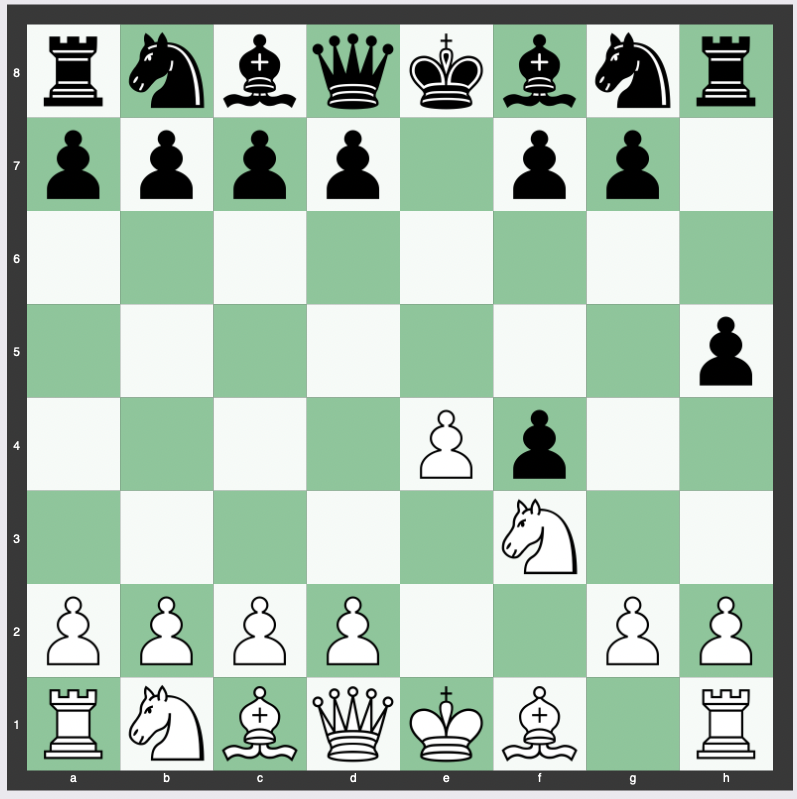The Wagenbach Defense, a notable contribution to the King’s Gambit theory, carries the unique hallmark of Hungarian-English chess player János Wagenbach.
This unorthodox defense, defined by the pawn movement 3…h5, is a remarkable example of leveraging positional advantage.
It challenges conventional chess principles by securing a specific structure on the king’s side.
Notably, the strategy involves sealing up the king’s side with subsequent …h4 followed by …g5 moves, preventing the undermining h2-h4 attack.
The Genesis of the Wagenbach Defense: János Wagenbach
János Wagenbach, a stalwart of Hungarian and English chess, is recognized for his ingenuity on the chess board.
Wagenbach’s analytical prowess and creative mind led to the development of this defensive strategy.
Drawing from his extensive understanding of the game, he fashioned an approach that encourages a proactive defense through a series of planned pawn moves.
Wagenbach Defense Move Order
The signature move of the Wagenbach Defense is the early 3…h5.
The complete move order of the Wagenbach Defense is: 1. e4 e5 2. f4 exf4 3. Nf3 h5

This atypical pawn maneuver seeks to establish a robust structure on the king’s side, reflecting Wagenbach’s innovative approach to the game.
The main goal of this movement is to secure the additional pawn on the f4 square while simultaneously preparing for a defensive pawn structure on the king’s side.
Ensuring Solidity: …h4 followed by …g5
Once the early 3…h5 move has been made, Black aims to seal up the kingside with …h4 followed by …g5.
This is a strategic approach, aiming to fortify Black’s position and establish a solid pawn structure.
This tactic secures the extra pawn on f4 without allowing an undermining h2-h4 attack from the opposition.
The Trade-off: Time
While the Wagenbach Defense provides a solid setup and secures a pawn, it does come with a significant drawback: time.
The amount of time required to execute this strategy can be considerable.
Every move in chess is a trade-off, and while the solid structure achieved is desirable, the time investment needed to reach this position can put the player under pressure, particularly in fast-paced formats of the game.
Evaluation of the Wagenbach Defense
The Wagenbach Defense is generally evaluated at around +1.00 to +1.35 for white.
Continuation Lines of the Wagenbach Defense
The most common reply to the Wagenbach Defense is 4. d4 or 4. Bc4.
Some continuation lines from the Wagenbach Defense include:
4. d4
4. d4 d5 5. exd5 Nf6 6. c4 Bb4+ 7. Nc3 O-O 8. Bxf4 Re8+ 9. Be2 Ne4 10. O-O Bxc3 11. bxc3
4. d4 g5 5. h4 g4 6. Ng5 f6 7. Bxf4 fxg5 8. Bxg5 Be7 9. Qd2 d6 10. Nc3 Be6 11. O-O-O Bxg5 12. hxg5 Ne7 13. Re1 Nd7 14. Nd5 Bf7 15. Bc4
4. d4 g5 5. h4 g4 6. Ng5 f6 7. Bxf4 fxg5 8. Bxg5 Be7 9. Qd2 d6 10. Nc3 Bxg5 11. hxg5 Be6 12. Bd3 c6 13. d5 Bf7 14. e5 dxe5 15. O-O-O Ne7 16. d6 Ng6 17. Ne4 Nd7 18. Rhf1 Nf4 19. Rxf4 exf4 20. Qxf4 O-O 21. Nf6+ Kg7 22. Nxd7 Qxd7
4. d4 g5 5. h4 g4 6. Ng5 f6 7. Bxf4 fxg5 8. Bxg5 Be7 9. Qd2 d6 10. Nc3 Be6 11. Bd3 Nd7 12. O-O Bxg5 13. hxg5 Qe7 14. Nb5 O-O-O 15. Qc3 c6 16. Nxa7+ Kb8 17. Nxc6+ bxc6
4. Bc4
4. Bc4 h4 5. Nc3 g5 6. h3 d6 7. d4 Nc6 8. a3 Bh6 9. Qd3 g4 10. hxg4 Bxg4 11. Bd2
Conclusion
The Wagenbach Defense is a testament to the strategic depth and variety inherent in the game of chess.
Its inventor, János Wagenbach, introduced a unique and unconventional approach to defending the king’s side.
While this strategy does require a significant investment of time, the resulting robust pawn structure on the king’s side has proven to be a viable defensive method.
The Wagenbach Defense serves as an intriguing example of how innovation and strategic insight can challenge and redefine conventional wisdom in the game of chess.


